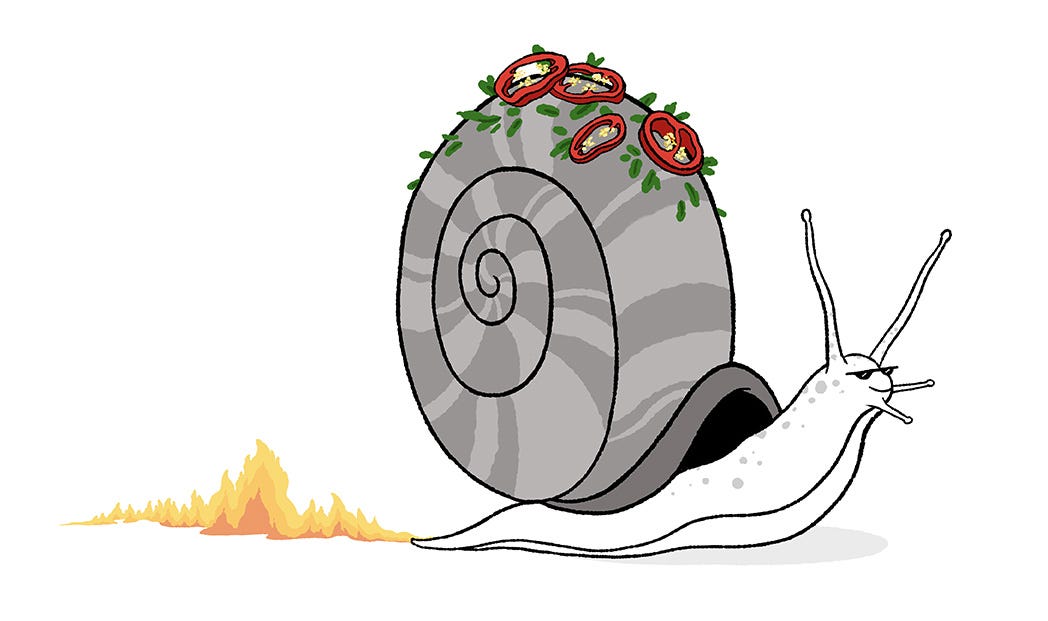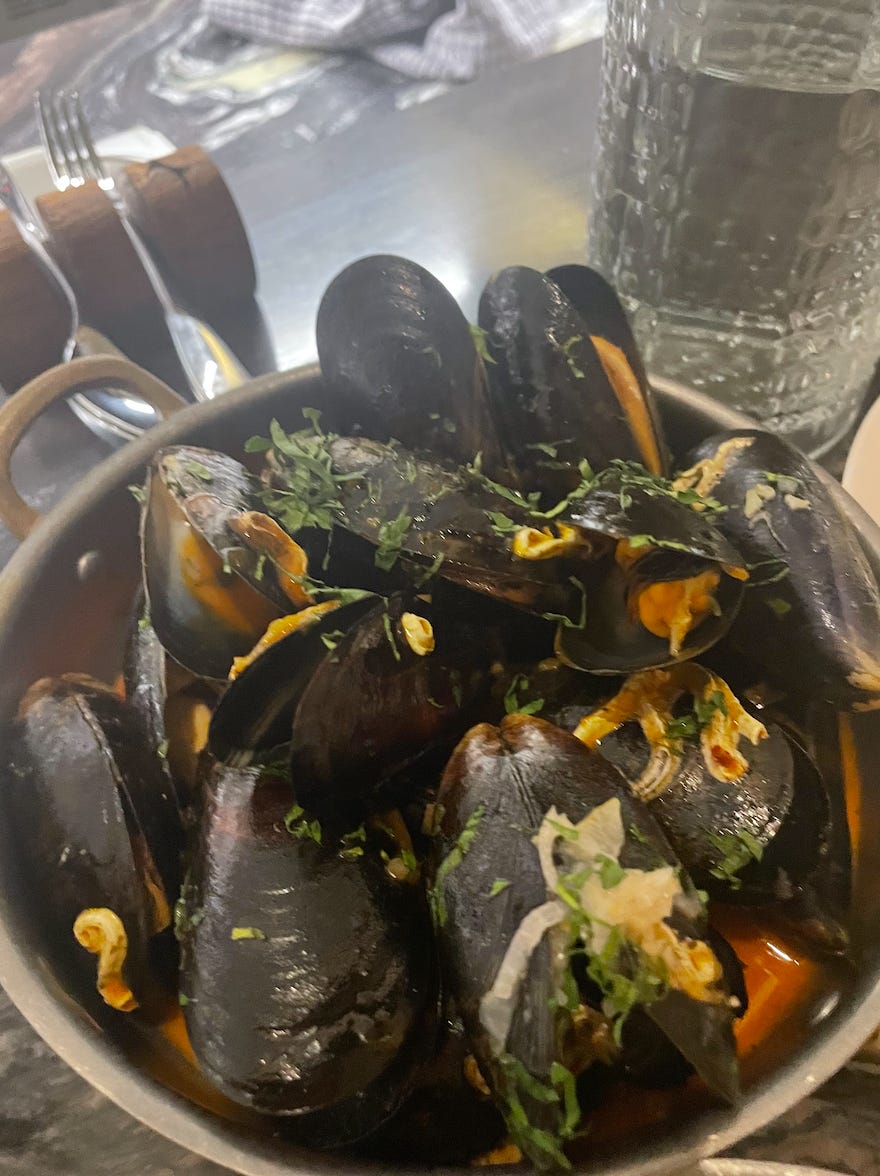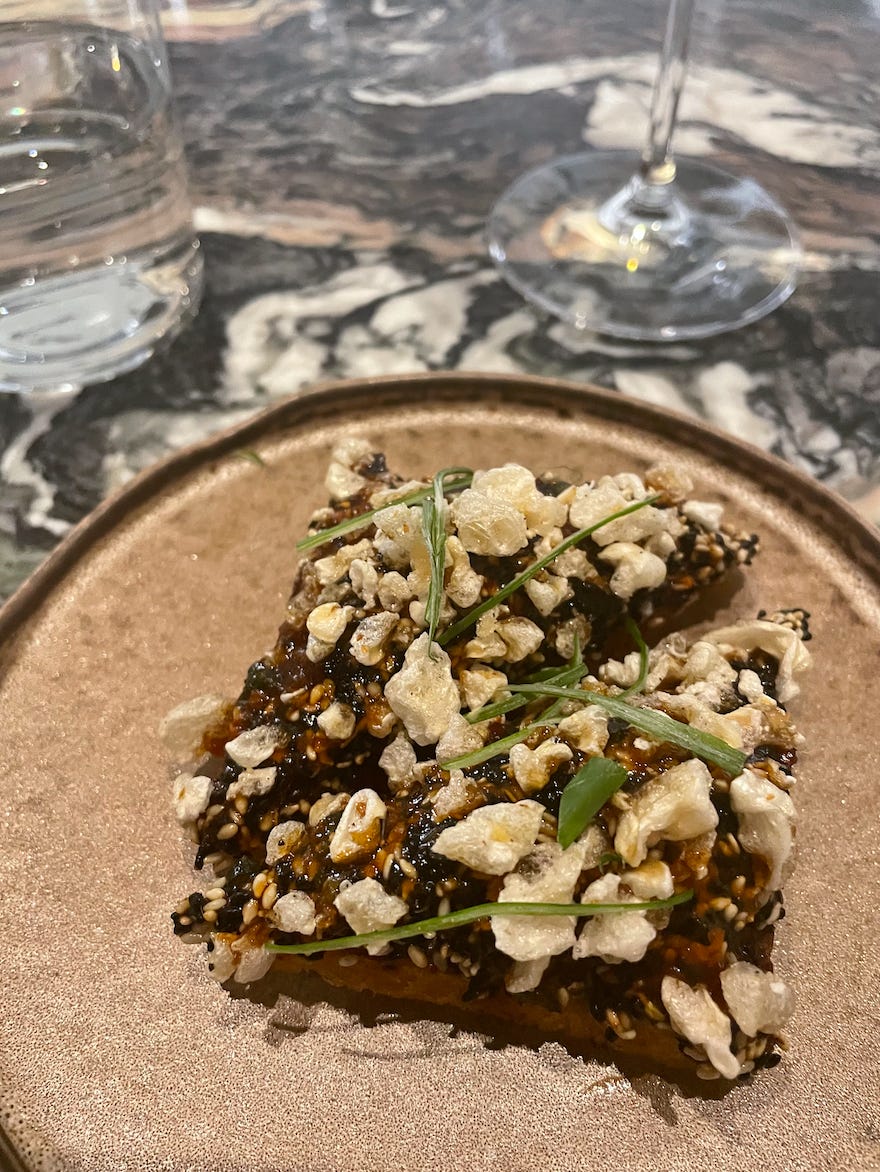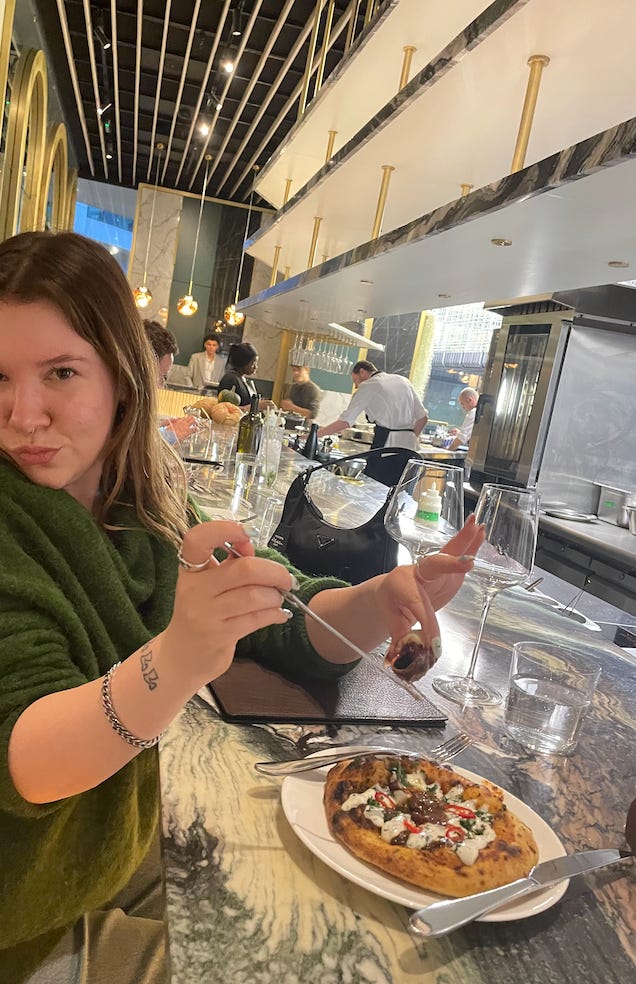In most of the posts I’ve written for Dining Out so far, I’ve talked quite a lot about social media. This is partly because of my own personal problems – I have a disease whereby my brain is rotting from the inside to a looping soundtrack of “Gemma Collins CBB Best Bits”, due to excessive screentime – but also partly because you can’t really have a discussion about popular restaurant culture in London without mentioning it.
Social media – Instagram, TikTok, whatever – is how most people tend to find out about new restaurants, because that’s how people tend to find out about everything. If your personal algorithm is in any way plugged into online food chat, restaurant recommendations come from all over the place. Sometimes they’re via a pal’s Story, sometimes it’s a restaurant’s own photos on your Insta Explore page. Occasionally, it’s a food influencer imploring you to “come with ME to this restaurant on a CANAL BOAT” or emphatically stating “this is the best sandwich in London”, half a sub roll hanging out of their gob while they nod maniacally down their phone at nobody and everybody.
The effect of all this, as I’ve discussed before, isn’t really good or bad – it’s more just a symptom of how we now move through the world, though of course it does mean that restaurants are somewhat missing a business trick if they don’t at least try to appeal to social media. At worst, this can mean gimmicks and food that looks the part but doesn’t meet expectations. But when it’s done well, you get something like Roe.
Roe is the brand new place from the people behind Fallow, a wildly successful “modern European restaurant” (chuck that on the “phrases that have come to mean absolutely nothing” pile while you’re there will you?) on Haymarket in central London. Roe is this group’s third opening, following the OG Fallow, and the chicken-focussed Fowl, which came last year. Fallow has a focus on sustainability, waste reduction, and British ingredients (Roe follows suit), and in the two-and-a-half years since it has had its permanent location, it has done a roaring trade.
This is owing in great part to the Instagram presence of founders Will Murray and Jack Croft. Via the account @herd.chefs, which has one million followers – that’s PrettyLittleThing ambassadorship deal levels, boys – they have somewhat led the charge on that whole “videos of professional chefs explaining how to chop herbs” type of thing, in a genuinely useful and sweet way.
In a bit of a chicken/egg scenario, then, the food showcased on the @herd.chefs account – that is, food from the kitchens at Fallow, Fowl, and now Roe – tends to be the sort of stuff that appeals widely on social media, in that it’s very outwardly indulgent-looking.
There are “cheese pulls”, and meat that glimmers with fat, and, at breakfast time, bright orange egg yolks that pop like fake blood capsules when you cut into them. I don’t think there’s anything wrong with that in and of itself – these things appeal widely because they’re known to be delicious – but the dominance of dishes like this both on social media and as a result, in restaurants, can sometimes make you wonder whether there’s a bit of style over substance going on. Is a dish like a “snail vindaloo flatbread” – on the menu at Roe – actually designed to taste amazing and exciting, as well as looking good under a ring light, and reading well in a caption?*
Given my fascination with the size of the space between the food we fantasise about tasting when we see it online, and the real life incarnations of those dishes, I was really intrigued to be invited for dinner at Roe. When the time finally came, I wrangled a friend, Hannah**, and went to investigate.
Roe is in Canary Wharf, which is a strangely vibeless location in which to open any hospitality business, though given the brand’s following, I suppose the restaurant in itself is a destination that will bring punters to it, more than it will attract walk-in diners simply passing through. When I arrived, I was mainly struck by the fact that the inevitable spectacle of the food was matched by the building itself.
The place is absolutely cavernous; it has the type of tall, curved interior walls that kind of put me in mind of the way they’re trying to make cruise ships appeal to young people. I don’t mean that as a positive or negative indicator, more just as an admission of scale – there’s no denying that the gaff looks extremely impressive and imposing. What I tend to enjoy about restaurants, though, is the intimacy they afford you and whoever you’re there with, so amid all that largesse, I was pleased when Hannah and I were seated at the chef’s counter. I think it’s probably the best seat in the house, because if you’re interested in cooking and process, you get to see the whole thing up close. It was also cool to chat to the chefs about what they’d made for us, so if you’re thinking about going to Roe and you love a bit of all that, my hot tip is to book that spot if you can.
We were greeted with cocktails – I’d been recommended the Carrot Gimlet, a riff on the classic cocktail using sweet carrot juice instead of lime cordial, in keeping with the restaurant group’s sustainable bent, which I thought was refreshing and cute. After necking our drinks, Hannah and I swiftly got down to choosing what we wanted to eat. While Fallow’s concept is split into “Plant” “Sea” and “Land”, at Roe, the menu is a sprawling list of sections that all basically mean “sharing plates”. There are “snacks”, “small plates”, “flatbreads”, “skewers”, “large plates” and “sides” (this, however, is not to mention the two final sections, which are outliers, labelled “feasting” and, simply, solemnly: “steaks”).
In general, the dishes don’t really feel united by any theme other than total maximalism – a skewer doesn’t come with fat chunks of sausage OR octopus but both; a bowl of mussels is supercharged with Sriracha – and so when you’re ordering it can feel like a bit of a crapshoot. On one hand, this is confusing because it’s hard to pick coherently – like, for our main “large plates” we ordered the mussels and a cheese drenched baked potato, which is, on paper, demented – but on the other, if you are like me and wish every meal was essentially an Adult Lunchable made up of many different textures and tastes to delight and surprise, you will enjoy it.
In the end, we went for a freewheeling selection of: breaded mushrooms, cuttlefish fried brioche, THEE snail vindaloo flatbread (more on this later, obviously), a cabbage skewer with miso, a smoked lemon chicken skewer with a hazelnut satay dressing, plus the aforementioned mussels and baked potato (desserts were mint “Viennetta” for me, ever the nostalgia glutton, Tunworth cheesecake for Hannah, and a few bites of banana parfait – very brave of me considering my historic fear of this fruit, but even I had to admit it was really great).
Everything, pretty much, is intended to be shared, and my major takeaway from the whole experience was that it basically felt like a whistle-stop tour through extremely amped-up versions of very popular dishes. Again, this has the mark of the type of food designed for social media greatness, at the centre of the Venn diagram labelled “accessible and novel” on one side and “properly ambitious and effective cooking” on the other. As I expected, it all sounded outrageous on the menu, but I genuinely didn’t think I’d be quite so thrilled by the execution.
This is hands-on food, actually honouring and delivering on the sensuality of the way these kinds of full-on dishes are presented online. For the most part, it’s also comfort food, turned up to eleven. Lots of the plates had, in my mind, a much simpler analogue or basis that forced me to root through my memories: the mushrooms, dusted in a spicy kombu seasoning, were shaped and sized like the little morsels of Popcorn Chicken I’d toss back like Scooby Snacks in front of The X Factor as a kid.
The fried cuttlefish brioche, dotted with crunchy pork skin, was like if Marie Antoinette designed her very own prawn toast – sticky, just the right side of oily and deep with sesame – and the chicken, which came as three wings on a skewer, was the most indulgent satay I’ve ever had, the hazelnuts lending the sauce a paler creaminess you don’t get with peanut (indeed, as I write this, a day later, I would probably do a minor but not insignificant crime for another serving of that chicken right now).
Of course, when you are chucking everything at the wall, it doesn’t all stick, and there are some dishes that annoyingly betray that social media-led sensibility that I wondered and worried about initially. To return to that “snail vindaloo flatbread”, for example: it sounds like an AI generated London restaurant dish, and having eaten it, I don’t think it makes a huge amount of sense outside of sounding good to say in an Instagram video, flatbreads (and snails, actually) being as currently viral as they are.
The dish doesn’t taste bad or anything – the bread is puffy and soft and everything you want a flatbread to be, and the mix of curry and cooling mint yoghurt is great – but a snail is such a delicate taste that it hardly seems worth including it, other than for reasons of popping an escargot on top, for a cool photo op (see below x). It’s a shame, too, considering that there are dishes on this menu where other mild flavours – the cuttlefish, piped onto the toast in a mousse to give it more power, for example – really shine, given space in among the heavier-hitting ingredients.
In general, though, I have to hand it to Roe: for the most part, this is food whose reality more than matches up to the idea of itself on the menu and online. Lots of this is also down to the feeling of actually being in the restaurant. I find that big social media spots can sometimes be lacking in ambience, but Roe is buzzy and fun, with a lot of thought put into how you receive the food (it’s all very showy: there are artfully tarnished metal bowls and wooden boards, and the skewers, which are hooked at one end, look like weapons from a three hour film about ancient Nordic warriors, lending them both a premium feel and an element of danger – very important at dinner). Crucially, the service is extremely warm, to the point of being some of the best I’ve experienced – attentive, knowledgeable, friendly, and all of the other great adjectives you’d hope for.
All of this added to the strong sense I got that Roe is a restaurant which is aware of its own responsibilities. When your food is so popular online that your restaurant is a destination in itself, it has to live up to your customers’ expectations: there is simply no other choice. Especially in the current climate, when money is tight and choosing to eat out at a restaurant is a genuine investment, chefs and restauranteurs can’t allow that gap between what someone hopes for their meal and what they actually get to be very big at all – and in fact, the food should actually exceed expectations, both in terms of what is served, and the full package restaurant at large. And aside from a couple of snail-based slip-ups, I think Roe gets there. It’s a good example of everything a social media-savvy restaurant can and should achieve, right now.
This visit was arranged by Crab Communications, but thoughts on snails and all other molluscs are my own.
* I reckon that often the best foods are ugly as fuck: a Greggs sausage roll is about as photogenic as me after five pints, but it’s still one of the most magnificent things you can buy with legal tender, know what I mean?
** Not the same Hannah from Toad Bakery; as a white woman born in 1994 I reserve my right to have like, seventeen different friends called Hannah.
Dining Out is written by Lauren O’Neill and illustrated by Lucy Letherland. It’s free to read every Thursday, but if you’d like to support what we do, you can do so here. To receive Dining Out directly to your inbox, subscribe via the button below:
See you next week!









